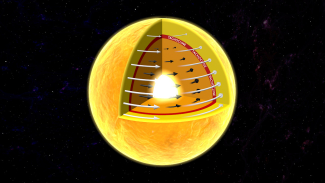Sitting 150 million kilometers away from the Earth, the Sun produces puzzling phenomena, like solar flares, that physicists are working to understand. One of these puzzles involves the Sun's tachocline, a belt of heat transition. “A tachocline is when the radiative interior of a star rotates like a solid ball, but the convection zone [an unstable outer heat layer in a star] rotates differently,” explained former JILA graduate student Loren Matilsky. “For geometric reference in the Sun, the outer 30% by radius is the convection zone, and the inner 70% by radius is the radiative interior.” Before leaving JILA to become a postdoctoral researcher at the University of California Santa Cruz, Matilsky collaborated with JILA Fellow Juri Toomre and his group at JILA to study the Sun's tachocline using computer simulations. In a new paper published in The Astrophysical Journal Letters, Matilsky, Toomre, and the team developed a new type of simulation, one where the tachocline is self-consistent and not artificially enforced, meaning that it arises on its own. According to Matilsky: “As far as we know, it's the first time this type of self-consistent tachocline behavior has been published for a fully nonlinear fluid dynamical global simulation.”
Sun Simulations
There are many types of simulations astrophysicists use to learn more about the Sun's tachocline. When the tachocline was discovered in 1992, physicists needed to come up with different reasons for why this transitional belt of heat existed on the Sun’s surface, including whether a magnetic field affected the flow. “Immediately after the tachocline's discovery, there were two [main] competing theoretical explanations for why it would exist,” said Matilsky. “The ‘fast’ scenario means there is no magnetic field, so the fluid outer layers are essentially experiencing shear instabilities, which arise when the spatial rate of change of the rotation rate is strong compared to the viscosity.” When the outer convective zone tries to burrow inward toward the solid core, the fluid dynamics of the scenario flattens out the zone. Which, according to the “fast” theory creates the transition layer of the tachocline. “It's called fast,” Matilsky continued, “ because these instabilities operate on a timescale of a convective overturning time or rotation period, so about every few days or maybe a month.” Compared to the millions of years it takes for a star to mature, a few days to a month seems rather rapid.
In contrast, the second “slow” scenario, includes a magnetic field as a source of the tachocline. As Matilsky explained: “The scenario is 'slow' because it wipes out differential rotation [the convective zone] on the long timescale (around billions of years) of deep global circulation.” The magnetic field helps to create the tachocline in this scenario, as opposed to fluid dynamics in the first scenario. Matilsky compared the magnetic fields to rubber bands that would prefer not to be bent. Similarly, if the field lines are stretched enough, there is a backlash and the burrowing process for the tachocline stops. There is, however, a third scenario involving a cyclical dynamo, a process that creates the Sun's magnetic field. “The dynamo field was assumed to follow the Sun's observed 22-year cycle for solar hotspots. The 22-year cycle refers to the fact that sunspots emerge in greater numbers, and with greater intensity, every 11 years. From one of these ‘sunspot cycles’ to the next, the field polarity reverses, making a 22-year cycle.” explained Matilsky. In the third scenario, the dynamo helps drive the tachocline, and this scenario is what Matilsky and Toomre explored in the simulation.
From their simulation, the researchers found that the tachocline became self-contained, arising on its own. “It was a self-consistently enforced tachocline,” Matilsky said. “I think there is a definite possibility that if you don't try to confine the tachocline artificially, it might just be there if you add a magnetic field.”
This self-contained tachocline may help astrophysicists to learn more about another of the Sun's phenomena, its magnetic field. “The main goal, I would say, of all solar physics is to understand the Sun's dynamo, because we have these flares—coronal mass ejections—which makes the news because they are firing high-energy particles that hit satellites in space, they're disrupting power grids, and that actually affects life on Earth. That comes from the solar magnetic field.” Matilsky and other physicists reason that the Sun's dynamo must originate at the tachocline, as opposed to previous thinking which suggested something else caused the tachocline. “Because the tachocline is the interface between differential rotation and solid body rotation, there's a lot of shear happening, and many believe that that [shear] is what is creating this powerful magnetic field," Matilsky added.
More on Exoplanets and Stellar Evolution
While the new simulation suggests a strong link between the tachocline and magnetic field, it also hints at more explanations about exoplanets. “Our paper may also provide significant insights into stellar dynamos,” said Matilsky. “We discover exoplanets all the time. Their space weather is really violent compared to the stuff we experience on Earth. So, if other stars have tachoclines, that may tell us if they have dynamos, which could affect exoplanets’ space weather.”
Insight into these tachoclines may also uncover more history about our Sun's origins. “During the early stages of stellar evolution, there's a whole bunch of theories relying on whether the magnetic field homogenizes the rotation rate or not,” Matilsky added. “Throughout all this, the presence or not of a tachocline (the boundary between homogenous [solid body] rotation rate and differential rotation) would definitely affect stellar evolution.” While there is still more research to be done, this paper is one more step forward to learning more about how stars originated.
Written by Kenna Hughes-Castleberry, JILA Science Communicator




